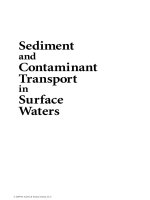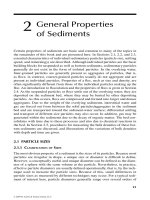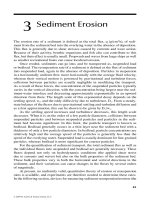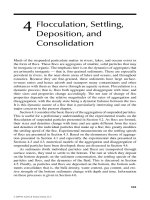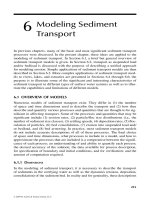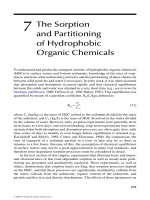Charge and spin transport in graphene based devices
Bạn đang xem bản rút gọn của tài liệu. Xem và tải ngay bản đầy đủ của tài liệu tại đây (12.94 MB, 157 trang )
1
CHARGE AND SPIN TRANSPORT IN
GRAPHENE-BASED DEVICES
AHMET AVSAR
DEPARTMENT OF PHYSICS
NATIONAL UNIVERSITY OF SINGAPORE
(2014)
2
CHARGE AND SPIN TRANSPORT IN
GRAPHENE-BASED DEVICES
AHMET AVSAR
A THESIS SUBMITTED
FOR THE DEGREE OF DOCTOR OF PHILOSOPHY
DEPARTMENT OF PHYSICS
NATIONAL UNIVERSITY OF SINGAPORE
(2014)
3
DECLARATION
I hereby declare that the thesis is my original work and it has been written by
me in its entirety. I have duly acknowledged all the sources of information
which have been used in the thesis.
This thesis has also not been submitted for any degree in any university
previously.
Date Ahmet Avsar
4
ACKNOWLEDGEMENTS
I would like to thank my supervisor, Prof. Barbaros Özyilmaz, for accepting
me to work in his research group. During the entire period of my studies, I
always felt his guidance, patience, support and care. Whenever I was stuck with
my experiments, I always got invaluable input from him to solve the problems I
was facing with. I admire his sixth sense while he was identifying the actual
problems. While the characterization of heterostructure devices took longer
than what we were expecting, he was always patient and gave me support and
encouragement. I will never forget his support and care while I had problem
with my scholarship during my PhD study. He created a wonderful laboratory
from scratch (though we still don’t have a couch and coffee machine) and I am
sure the group will do breakthrough research more often in the coming future.
I am grateful to the head of graphene research center, Prof. Antonio Helio
Castro Neto, for his invaluable discussions and theoretical support during my
studies. His leadership while managing the world class center, his deep
theoretical understanding of the matter and most importantly his interpretations
on experimental results always amazed me. He is a truly role model for me. The
special thanks go to Dr. Alexandra De Carvalho for her theoretical supports and
discussions.
I especially thank to Dr. Jayakumar Balakrishnan, Mr. Gavin Kok Wai Koon
and Mr. Jun You Tan. I would never be able to complete my studies without
their helps. Dr. Jayakumar Balakrishnan was always there whenever I need to
discuss anything related to transport phenomena in graphene. Mr. Gavin Kok
Wai was always helping me whenever I need a hand while I was working with
MBE system or doing measurements. He has an eidetic memory and you should
not leave your credit card numbers around him. I don’t know how to express
my gratitude to Mr. Jun You Tan. It was impossible to make heterostructure
project work without his hard working and problem solving abilities.
5
I am grateful to Dr. Xu Xiangfan for his guidance at the early stage of my
PhD studies. The weekly spin meetings were very beneficial thanks to the
critical discussions with Dr. Eoin O’Farrel and Dr. Thiti Tychatanapat. Dr.
Tychatanapat was always patient with my simple transport questions and his
magic program made the proximity work possible. I will like to extend my
gratitude to all my group members especially Mr. Henrik Andersen, Mr. Orhan
Kahya, Dr. Jong Hak Lee, Dr. Raghu Sharma, Mr. Wu Jing, Mr. Chee Tat Toh,
Ms. Yuting Yeo, Dr. Steven Koenig, Mr. Alexandre Pachoud and all members
of Özyilmaz group and graphene research center for their friendship and help
during my PhD studies.
I would like to thank Prof. Gernot Güntherodt, Prof. Bernd Beschoten, Dr.
Tsung-Yeh Yang and Mr. Frank Volmer from the RWTH Aachen University,
Prof. Byung Hee Hong and Dr. Su-Kang Bae from the Sungkyunkwan
University for their help at the initial spin transport experiments.
I would also like to thank my close friends Dr. Mustafa Eginligil, Mr Mehmet
Erdogan and Mr. Kadir Durak. Singapore is a memorable place for me with
their accompany. I also like to thank Mr. Orkun Saka for his constant support
and helps from high school to now.
I would like to gratitude my family. Without their support and faith, I would
never find a chance to follow my dreams and reach this point. I will never
forget the moment while my brother, Mr. Mehmet Avsar, was convincing my
parents for my initial internship and PhD studies at abroad. Finally I thank Ms.
Saziye Yorulmaz (Avsar (soon)) for her patience and love.
6
TableofContents
ACKNOWLEDGEMENTS 4
ABSTRACT…… 8
LIST OF FIGURES 10
CHAPTER 1 INTRODUCTION 22
1.1 SPINTRONIC 22
1.2 THESIS OUTLINE 24
CHAPTER 2 BASIC CONCEPTS 26
2.1 ELECTRICAL SPIN TRANSPORT 26
2.1.1 Electrical spin Injection and detection 26
2.1.2 Non-local spin valve geometry 29
2.1.3 Electrical spin precession 31
2.2 SPINTRONICS PROPERTIES OF GRAPHENE 34
2.2.1 Introduction 34
2.2.2 Spin scattering mechanisms in graphene 34
2.3 SPIN HALL EFFECT 36
2.3.1 Introduction 36
2.3.2 Generation and detection of spin current via SHE 37
2.4 GRAPHENE 39
2.4.1 Introduction 39
2.4.2 Band structure of graphene 39
2.4.3 Electronic properties of graphene 41
2.4.4 Electronic transport in graphene under magnetic field 44
CHAPTER 3 EXPERIMENTAL TECHNIQUES 48
3.1 PRODUCTION OF 2D CRYSTALS 48
3.1.1 Preparation of mechanically exfoliated graphene 48
3.1.2 Preparation of CVD grown graphene 51
3.1.3 Preparation of exfoliated 2D crystals beyond graphene 53
3.2 PREPARING A GRAPHENE-BASED HETEROSTRUCTURE DEVICE 54
3.2.1 Introduction 54
3.2.2 Dry transfer method 54
3.2.3 Electron beam lithography 57
3.2.4 Recipe for heterostructure device fabrication 59
3.3 PREPARING A GRAPHENE SPIN TRANSPORT DEVICE 63
7
3.3.1 Introduction 63
3.3.2 Recipe for spin transport device fabrication 63
3.4 MEASUREMENT SET-UPS AND TECHNIQUES 67
3.4.1 Measurement set-ups 67
3.4.2 Charge transport measurements 68
3.4.3 Spin transport measurements 69
3.4.4 Spin Hall effect measurements 70
CHAPTER 4 SPIN TRANSPORT IN CVD SINGLE LAYER AND BI-LAYER GRAPHENE71
4.1 INTRODUCTION 71
4.2 SPIN TRANSPORT IN EXFOLIATED SINGLE LAYER AND BI-LAYER GRAPHENE 72
4.3 SPIN TRANSPORT IN CVD SINGLE LAYER AND BI-LAYER GRAPHENE 78
4.4 CONCLUSION 91
CHAPTER 5 SUBSTRATE ENGINEERING FOR GRAPHENE-BASED
HETEROSTRUCTURES 92
5.1 INTRODUCTION 92
5.2 SUBSTRATE 93
5.3 CHARGE TRANSPORT IN GRAPHENE ON VARIOUS SUBSTRATES 95
5.4 CONCLUSION 107
CHAPTER 6 SPIN-ORBIT PROXIMITY EFFECT IN GRAPHENE 108
6.1 INTRODUCTION 108
6.2 CHARACTERIZATION OF WS
2
CRYSTAL 109
6.2.1 Growth and XPS of WS
2
crystal 109
6.2.2 AFM and Raman characterization 111
6.3 CHARGE TRANSPORT IN GRAPHENE-WS
2
HETEROSTRUCTURES 112
6.4 SPIN HALL EFFECT IN GRAPHENE-WS2 HETEROSTRUCTURE 117
6.5 CONCLUSION 129
CHAPTER 7 SUMMARY AND FUTURE WORK 130
BIBLIOGRAPHY 136
LIST OF PUBLICATIONS 157
8
ABSTRACT
The field of spintronics offers new technologies and fundamental discoveries
by using the spin degree of freedom of electron. Having low spin orbit
coupling, negligible hyperfine interaction and extremely high electronic quality
make graphene a promising material for spintronics studies. While the
exceptionally long spin relaxation length was demonstrated experimentally in
mechanically exfoliated graphene-based spin valve devices, the manipulation of
spin current for the practical applications was missing. The experimental work
presented in this thesis focuses on understanding the fundemantal spin transport
properties of graphene to prepare it for future spintronics applications.
In the first part of the thesis, I study the spin transport properties of CVD
grown graphene. Spin injection, transport and detection in CVD single and bi-
layer graphene are successfully demonstrated. I show that the CVD specific
structural differences such as wrinkles, grain boundaries and residues do not
limit spin transport properties of CVD graphene. The observation of long spin
relaxation length comparable to the exfoliated graphene samples makes CVD
graphene a promising material of choice for possible spintronics applications.
The large scale CVD grown graphene also allows the batch-fabrication of large
arrays of lateral spin valve devices with a fast-around time well suited for
studying the device physics.
In the second part of thesis, charge transport property of graphene is studied
in heterostructure devices. While the graphene field effect transistors fabricated
on various 2D substrates show enhanced electronic mobilities compared to
conventional SiO2 substrate, BN and WS
2
substrates appeared to be the most
promising substrates to reach high electronic mobilities in graphene. Our results
raise the importance of ideal choice of material for graphene-based
heterostructure devices before building the complex heterostructures.
The absence of significant spin orbit coupling in graphene is detrimental for
the manipulation of spin current in graphene based devices. In the last part of
9
thesis, I demonstrate that with the creation of an artificial interface between
graphene and WS
2
substrate, graphene acquires a SOC as high as 17meV with a
proximity effect, three orders of magnitude higher than its intrinsic value. This
proximity effect leads to the spin Hall effect even at room temperature. These
results open the doors for the realization of Datta-Das type spin field effect
transistors.
10
List of Figures
Figure 2-1. Density of states(DOS): Schematic representation of DOS for (a)
ferromagnet material, (b) unpolarized non-magnetic material and (c)
polarized non-magnetic material. The spin polarized current generates
spin accumulation in non-magnetic materal. 28
Figure 2-2. Non-local spin valve transport: (a) Schematics for a graphene based
non-local spin-valve device. This geometry separates the charge and
spin currents. (b) Room temperature bi-polar non-local spin signal in a
graphene based spin valve device as a function of in-plane magnetic
field. 30
Figure 2-3. Hanle spin precession: (a) The oscillation of spin signal as a function
of precession angle. (b) The schematics of spin precession
measurement for different polarization configurations. Black arrows
represent the polarization directions of ferromagnetic contacts and blue
arrows represent the precession of spin signal under perpendicularly
applied magnetic field. 32
Figure 2-4. Hanle spin precession: Spin precession measurement in graphene
based spin valve by employing non-local spin valve geometry. The
circles represent the measurement data and the lines represent the
fitting of the signal. Red (black) color shows the room temperature
measurement result when the relative orientation of injector and
detector ferromagnets are parallel (anti-parallel). 33
Figure 2-5. The spin scattering mechanisms: The schematics for (a) Elliott-Yafet
type spin scattering mechanism and (b) Dyakonov-Perel type spin
scattering mechanism.The red arrow represent the diffusion direction
of spin current, yellow sphere represent the momentum scattering site,
black arrow represent the the direction of effective magnetic field. 35
Figure 2-6. Spin Hall effect: (a) Charge current induced spin Hall effect and (b)
Spin current induced spin Hall effect.The red and black arrows
represent the motion direction of scattered charges, the blue arrow
11
represent the the direction of spin. Turquoise (green) arrow represent
the flow direction of spin (charge) current. 36
Figure 2-7. Spin Hall effect (SHE): (a) The schematics of SHE configuration.
Red arrow represents the flow direction of charge current and blue
sphere with the arrow represent the spin current. (b) The modulation of
SHE induced spin signal as a function of magnetic field. 38
Figure 2-8. The electronic band structure of single layer graphene: (a) The
triangular sublattice of graphene. Each A atom has three nearest
neighbours carbon atom of B. (b) The band structure of graphene with
the first Brillioun zone. 40
Figure 2-9. The resisitivity of graphene as a function of charge carriers. The
charge carrier type and density are tuned with an application of back
gate voltage from Si/SiO
2
gate electrode 42
Figure 3-1. The mechanical exfoliation of graphene: (a-f) The steps involved in
the production of graphene with mechanical cleavage method using the
scotch tape. The same technique is also used to produce thin layers of
BN, WS
2
, MoS
2
, and GaSe. 49
Figure 3-2. The optical images of exfoliated 2D crytsals: Optical images of (a)
mechanically exfoliated single layer graphene,(b) CVD grown single-
layer and bilayer(flower shape) graphene, mechanically exfoliated thin
layers of (c) BN, (d) WS2, (e) MoS2, and (f) GaSe. Scale bars in each
image is 10 μm. 50
Figure 3-3. The transferring of graphene on arbitrary 2D crystal substrates: The
transfer process involves (a) the exfoliation of graphene on
PMMA/PMGI bilayer resist stack. MF319 developer removes the
PMGI and graphene/PMMA layer floats on surface. (b)
Graphene/PMMA layer is cleaned from residues with DI water. (c)
Graphene/PMMA layer is scooped with a washer and (d) transferred
onto 2D crystal with a support glass slide by using an optical
microscope. The inset in (c) represents the optical pictures of washer,
12
transfer slide and the mounting of transfer slide to the system. 55
Figure 3-4. The experimental tools for device fabrication: (a) The Nova
nanoSEM-230 system is used for the electron beam writing of
graphene mesoscopic devices. It provides beam voltages ranging from
1kV to 30 kV. The dedicated patterning software(Nabity, NPGS &
designCAD) allowed to generate small size patterns down to few
nanometers (b) The UHV-MBE chamber is specifically designed for
the growth of tunnel barriers for spin transport studies. This UHV
system uses many pumps including roughing, turbo, cryopump,
titanium sorption and ion pumps to maintain an ultra high vacuum in
chamber (base pressure is in the low 10
-10
Torr range) and it is
equipped with two high power multi-pocket linear electron beam
evaporators(6*8cc capacity and 9Kw), an effusion cell and a thermal
source with three boats. The unique rotating arm manipulator of this
system can rotate the 2” substrate 360 degree; therefore travel from
source to source is possible for sequential deposition cycles with an
option to change the height and angle of the sample with respect to
deposition source. All these components are controlled via lab view
software for remote control. (c) One of the electron beam source in the
UHV system with its crucibles, crucible hearth and shutter. 58
Figure 3-5. The illustration of device fabrication steps for building the graphene
based heterostructure devices: (a) Bilayer PMMA is spin coated on the
wafer and (b) an etch mask is patterned with electron beam
lithography. (c) graphene at the ouside of PMMA mask is ecthed with
oxygen plasma and (d) finally PMMA mask is removed with acetone
to finish the graphene patterning process. For creating the metal
contacts, (e) a new fresh PMMA is spin coated on patterned graphene,
followed by (f) a patterning step with electron beam lithography. (g)
Device is evaporated with chromium and gold metals. Thin chromium
layer increases the adhesion of gold contacts to the wafer (h) The
13
excess metal is lifted off with acetone and the remaining metals on
graphene forms the electrodes. 59
Figure 3-6. Bubble characterization: (a) AFM image of a single bubble. The
height of bubble varies from 40 nm to 100 nm and the length of bubble
reaches up to 1μm. The darker area shows the graphene on BN
substrate and the white dots in the image shows the bubbles. Optical
images of a bubbled sample before and after the annealing step are
shown in (b) and (c), respectively. The annealing step removes the
small size bubbles and create a larger area for the device fabrication.
Scale bar is 10 μm. (d) The annealing set-up with a vacuum station.
Before Ar/H2 gas is sent to the furnace for annealing process, tube is
pumped down for 30 mins. 61
Figure 3-7. Optical images of a fabricated graphene device on boron nitride
substrate: (a) Bright field imaging of graphene on PMMA/PMGI
polymer stack. Scale bar is 10 μm. (b) Dark field imaging of a
transferred graphene on boron nitride substrate after the annealing
step. The white spots show the bubbles and the white lines shows the
edges of graphene. The bubble free area is selected for the device
fabrication. (c) The designCAD of device with NPGS software for
electron beam lithography. Green and purple colors represent the
contact and etch mask patterns respectively. (d) Electron beam
lithography is utilized to writing the etch mask for patterning the
graphene. (e) Dark field imaging of Hall bar patterned graphene on
boron nitride. (f) Optical image of device after contact patterning.
Scale bar is 500 μm. (g) and (d) represents the final device after
annealing process for small and big contacts. 62
Figure 3-8. Device fabrication for CVD graphene based spin valve devices: (a)
CVD graphene is transferred onto 300nm SiO2 wafer after etching the
Cu substrate. Scale bar is 10 μm. (b) CVD graphene is etched with
Oxygen plasma into stripes with different widths. Electron beam
14
lithography is utilized for patterning the (c) small and (d) big electrode
patterns. 64
Figure 3-9. AFM scans for the optimized ultrathin MgO tunnel barrier on
graphene: (a) Topography of graphene on SiO2 substrate. (b)
Topography of graphene after pre-annealing step (200C annealing for
1 hour). (c) AFM image of graphene after the deposition of 1.5nm
MgO. (d) AFM image the sample after a post annealing step (200C
annealing for 1 hour). The rms values of scans are (a)=0.189nm,
(b)=0.208nm, (c)= 0.329nm and (d)=0.221nm. 66
Figure 3-10. Measurement set-up: The lock in (SR 830) is used during all
transport measurement performed in this thesis. Keithley 6430 is used
to apply gate voltage. The measurement configurations for (a) Hall
effect, (b) spin transport and (c) spin Hall effect measurements are
shown. I represents the injected charged current between source and
drain electrodes, V represents the measured potential at the interest
area. 68
Figure 4-1. Spin transport measurement in exfoliated single layer graphene: (a)
Schematics of non-local geometry. The zoomed area shows the
schematic for the precession of spin signal under perpendicular
magnetic field. Black arrow represent the polarization direction of
ferromagnet and blue sphere with the arrow represent the precession of
spin. (b) The room temperature conductivity of graphene as a fucntion
of charge carrier density (c) Spin transport measurement in non-local
gemetry. (d) Out of plane magnetic field dependence of nonlocal spin
signal. 73
Figure 4-2. Charge carrier density dependent spin transport measurements in
exfoliated single layer graphene: (a) Back gate voltage dependence of
spin diffusion constant, spin relaxation time and spin relaxation length
at 300K and 5K. (b) Temperature dependence of spin diffusion
constant, spin relaxation time and spin relaxation length at different
15
back gate voltages (Vbg=CNP, 20V and -20V) 75
Figure 4-3.Charge carrier density dependent spin transport measurements in
exfoliated bi-layer graphene: Carrier density dependence of
conductivity, spin relaxation time and spin relaxation length at 300K
and 5K. 77
Figure 4-4. CVD graphene-based spin valve fabrication: (a) Helium Ion
microscopy image of transferred CVD grown graphene on SiO2
substrate. Inset: Scanning electron microscopy image of sub-
monolayer graphene coverage on Cu. The grain boundary size is
~50μm. (b) High resolution contact mode AFM image of CVD
graphene after transfer onto Si/SiO
2
wafer revealing the presence
localized nanoscale ripples of high density. (c) Raman spectra of CVD
single and bilayer graphene on Si/SiO
2
substrate (300 nm SiO
2
thickness) with their optical image. Black and red circles indicate the
Raman spectroscopy locations. Blue arrows point to low density
wrinkles typical for CVD graphene films. (d) Scanning electron
micrograph of CVD SLG spin sample with multiple non-local spin
valve devices. Electrode widths range from 0.3 μm to 1.2 μm. (e)
Optical image of a 3 × 5 device array. CVD graphene allows the
fabrication of large arrays of identical lateral spin valves. (f)
Schematics for a graphene based non-local spin-valve together with a
possible configuration of quasi-periodic nano-ripples in a spin-valve. 79
Figure 4-5. Charge transport characterization of single and bi-layer graphene-
based devices:(a&c) Charge carrier density dependence of
conductivity in single and bi-layer CVD graphene. (b&d) Quantum
Hall effect in single an bi-layer graphene. 80
Figure 4-6. Spin transport characterization of single layer graphene-based spin
valve device: (a) Conductivity of CVD single layer graphene at RT and
at T = 5 K as a function of carrier density with a strong asymmetry
between electron and hole doped region. (b) Bi-polar spin signal
16
obtained in spin valve device at the charge neutrality point. (c) Hanle
spin precession measurement confirms the spin signal obtained in b).
(d) The carrier density dependence of momentum and spin relaxation
times. Both quantity increase with increasing electron carrier density.
(e) Linear dependence of momentum and spin relaxation times
showing that EY like spin scattering is dominant in CVD SLG. 82
Figure 4-7. Spin transport characterization of bi-layer graphene-based spin valve
device: (a)Conductivity of CVD bi-layer graphene at RT and at T = 5
K as a function of carrier density. (b & c) Spin valve and spin
precession measurements in CVD BLG, respectively. (d) Electron
carrier density dependence of momentum and spin relaxation times
at
RT. (e) Scaling of both quantities indicates DP type spin scattering as
the dominant spin scattering mechanism in CVD BLG. 84
Figure 4-8. Estimate of the SOC strength induced by nanoripples in CVD
graphene: (a) The schematics of ripple formation in CVD graphene.
The step edges in Cu give rise to nano-ripples in transferred CVD
graphene. (b)The AFM image of nano-ripples in Cu-CVD graphene.
(c) The Gaussian fit to the nano-ripple for determining the radius of
curvature R. (d) Radius of curvature determined from the Gaussian fit
to the nanoripple. 87
Figure 4-9. Temperature dependent spin transport measurements in CVD single
and bi-layer graphene: (a) Temperature dependent spin relaxation time
and lenght are shown for CVD grown single layer graphene for three
different electron carrier densities. (b) The temperature dependences of
spin relaxation time have different behavior at different doping levels
in CVD bi-layer graphene. Spin relaxation length depends very weakly
on temperature, but its carrier dependence is much weaker than for
CVD single layer graphene. Spin relaxation length is observed to be
very weakly dependent on temperature for fixed carrier densities in
both CVD singleand bi-layer graphene, since different temperature
17
dependence trends of spin relaxation time and spin diffusion constant
almost suppress each other in both systems. 88
Figure 4-10. Charge carrier density dependent spin transport measurements in
CVD single and bi-layer graphene: (a) Charge carrier density
dependence of spin relaxation time and spin relaxation length at room
temperature and at 5 K for CVD single layer graphene. (b) Charge
carrier density dependence of spin relaxation time and spin relaxation
length at room temperature and at 5 K for CVD bi-layer graphene.
Note that the carrier density dependence of spin relaxation time of
CVD bi-layer graphene at 5 K shows an opposite trend compared to
the measurement at room temperature. 89
Figure 4-11. Charge carrier density dependent spin transport measurements in
CVD single and bi-layer graphene: The carrier density dependence of
spin signal, spin diffusion constant and spin polaraziation in CVD (a)
single and (b) bi-layer graphene at room temperature. 91
Figure 5-1. Topography images of various 2D crystals: Typical AFM scanning
images of (a)BN, (b) WS
2
, (c) MoS
2
, (d-e) GaSe immediately after
exfoliation and 1 day after exfoliation and (f) SiO
2
. Height scale of the
AFM image is 0-3 nm and scanning dimension is 1μmx1μm. (g-h)
Height histogram and rms analysis of the images shown in panels (a-f)
respectively. 94
Figure 5-2. Resistivity measurement of a graphene field effect transistor on SiO
2
substrate as a function of back gate voltage at room temperature. Inset:
A completed graphene Hall bar device on SiO
2
substrate. The
schematics represent the positions of Fermi surface at different back
gate voltages. 96
Figure 5-3. Charge transport in graphene\BN heterostructures: (a) Temperature
dependent resistivity of a graphene field effect transistor on BN
substrate as a function of back gate. Inset: A completed graphene Hall
bar device on BN substrate. (b) Back gate voltage dependence of
18
graphene resistivity at room temperature. Graphene device is
sandwiched between SiO
2
substrate and a thin BN crystal. Inset: A
completed graphene Hall bar device encapsulated with a BN crystal. 99
Figure 5-4. The characterization of bubble: (a) Raman spectrum of graphene on
BN substrate. Red and black represents the spectrums taken at inside
and outside of the bubbled graphene. (b) Resistivity measurements of
graphene field effect transistor fabricated on BN substrate across a
bubble as a function of back gate voltage at room temperature. Inset:
Dark field image of etched graphene (green line) before contacts are
formed(purple line).The width of graphene channel is 1 μm. 100
Figure 5-5. Charge transport measurement in graphene-based heterosrtuctures:
(a&b) Resistivity measurements of graphene field effect transistors on
WS
2
and MoS
2
substrates as a function of back gate voltage at room
temperature. Insets: Completed graphene Hall bar devices on WS
2
and
MoS
2
substrate. 101
Figure 5-6. Charge transport characterization of graphene on GaSe substrate: (a)
Resistivity measurement of graphene field effect transistor on GaSe
substrate as a function of back gate voltage at 5K with forward and
backward back gate voltage scans. (b) Resistivity of graphene on GaSe
substrate as a function of back gate voltage with different back gate
sweep rates 102
Figure 5-7. Optical image of GaSe: The dark field images of a GaSe crystal,
captured just after exfoliation with 20 seconds interval. The size of
flake is ~ 40 μm and thickness is ~14.5 nm. 104
Figure 5-8. Charge transport characterization of graphene on GaSe substrate: (a)
Resistivity of graphene on GaSe substrate as a function of different
back gate voltage ranges at 5K. Black and red arrows represent the
sweep directions from negative to positive and positive to negative. (b)
Temperature dependent resistivity measurements in graphene on GaSe
substrate as a function of back gate voltage. 106
19
Figure 6-1. XPS of WS
2
crystal: (a) XPS survey scan of WS2 crystal acquired
with Mg Ka line. (b) High resolution XPS of W
4f
and S
2p
core levels. 110
Figure 6-2. AFM and Raman characterization of WS2 crytsal: (a) Optical and
AFM images of a representative WS
2
flake. Color scale of the AFM
image represents 0-20 nm.(b) Raman spectrum of few layers WS
2
with
and without graphene. 111
Figure 6-3. Device fabrication and systematics of graphene/WS
2
heterostructures: (a) Schematics representation of a multilayer
WS
2
/Graphene heterostructure device. The highest unoccupied state of
the sulphur vacancy is depicted in yellow, highlighting on the W atoms
closest to the vacancy. W, S and C atoms are represented by dark gray,
orange and light gray spheres, respectively. (b) Optical micrograph of
a completed device with multiple Hall bar junctions on G/ WS
2
heterostructure and a two terminal device on WS
2
. The scale bar is
2μm. (c) Schematics for the local and non-local measurement
configurations. 113
Figure 6-4. Electronic transport measurement in graphene on WS
2
substrate: (a)
Local resistivity (black lines) and conductivity (red line) measurement
as a function of back gate voltage at 1.5 K. (b) Landau fan diagram of
longitudinal resistance as a function of magnetic field and back gate
voltage. (c) Corresponding plots of longitudinal resistance as a
function of back gate voltage at constant magnetic fields. (Black and
red lines represent 4.5 T and 12 T respectively.) Inset: Carrier
concentration as a function of applied back gate voltage. 114
Figure 6-5. (a) Two terminal resistance measurement in few layers of WS2 flake
at 1.5K. (b) Conductivity measurement of graphene on WS
2
substrate
as a function of top gate voltage through a PVDF top dielectric. 115
Figure 6-6. Electronic transport measurement in graphene on WS
2
substrate:
(a&b) Landau fan plots of longitudinal resistance at 15K and 30K, (c)
Amplitude of SdH oscillation as a function magnetic field at different
20
temperature values. (d) Calculated effective mass and carrier
concentration as a function of back gate voltage. 116
Figure 6-7. Spin transport measurement in graphene on WS
2
substrate: (a)
Nonlocal resistance measurement as a function of back gate voltage at
RT in a reference graphene/SiO
2
device, Sample A, (red line) with its
calculated Ohmic contribution (black line). (b-c) Nonlocal
measurement for Sample B and Sample C at 1.5K and RT respectively.
(d) Fan diagram of nonlocal resistance as a function of in-plane
magnetic field and back gate voltage. Color scale bar is adjusted to
show between 12-20 Ω for clarification. Corresponding plots of non-
local resistance as a function of in plane magnetic field at constant
back gate voltages.(Black, pink and red lines represent the back gate
voltages of 37 V , 2V (D.P.) and 37 V respectively.) 118
Figure 6-8. Spin transport measurement in graphene on WS
2
substrate: (a,b)
Local conductivity and non-local resistance measurement of graphene
on WS
2
substrate. Black curve in (b) represents the Ohmic contribution
to the non-local signal. The threshold voltage for this sample is at 29V.
c - Non-local signal as a function of in plane magnetic field at back
gate voltages of 13V -13V. The threshold voltage for this sample is at
10V (not shown). 120
Figure 6-9. (a) Resistivity and conductivity of graphene as a function of V
BG
at
2K. Inset shows the AMF picture of graphene channel on WS
2
substrate. (b) Non-local resistance as a function of V
BG
. (c) Non-local
resistance as a function of in-plane applied magnetic field at V
BG
=
60V, 40V, CNP and -60V. 122
Figure 6-10. (a) Current bias dependence of non-local signal. Inset shows the
current bias and magnetic field dependence of non-local signal. (b)
Spin precession measurement with a fixed current bias at 1.5 μA. 123
Figure 6-11. The summary of measured samples. While the spin signal presents
in all samples, the non-local signal at Dirac point has sample to sample
21
variation. 124
Figure 6-12. Quantum interference effect in graphene on WS
2
substrate:
Normalized conductivity of graphene under perpendicularly applied
magnetic field at 50mK at different back gate voltages. 125
Figure 6-13. Bandstructures for the interface between graphene and monolayer
WS
2
and sulphur vacancy in bulk WS
2
. In the latter, a rigid shift of 0.2
eV has been applied to the unoccupied states to correct the bandgap to
the experimental value. 127
Figure 6-14. (a) Optical and AFM images of a transferred graphene on WS
2
substrate. Red dashed lines represent the border of graphene flake for
better clarify. (b) Resistivity and conductivity of graphene as a
function of back gate voltage at 2K. (c) Landau fan plot of longitudinal
resistance as a function of back gate voltage and magnetic field. (d)
Non-local spin signal measurement in non-annealed sample 128
Figure 7-1. Side contact spin valve device: (a) The optical picture of
BN/Graphene/BN heterostrusture after the transfer process. Single and
multi-layer graphene (SLG and MLG respectively) are encapsulated
between a bottom layer boron nitride (BL-BN) and a top layer boron
nitride (TL-BN) crystals. The scale bar is 5um. (b) The bubble free
graphene area is etched. (c) The final device after 30nm Co and 5nm
Au contacts are formed. (d) Resistivivity of graphene as a function of
back gate voltage at room temperature. (e) Spin precession experiment
in two terminal local geometry. 133
Chapter 1 Introduction
22
CHAPTER 1 Introduction
1.1 Spintronic
The discovery of electron, an elementary particle, by J.J. Thomson in 1897
started a new era in science and technology. After having a better understanding
of the fundamental properties of this charged particle, J. Bardeen, W. H.
Brattain and W. B. Shockley created the first transistor in 1947 at Bell
laboratories[1]. This discovery is the building block of the modern electronic
devices. In fact, by using neutral silver atoms, O. Stern and W. Gerlach had
shown that electrons have intrinsic angular momentum[2]. In 1925, G.
Uhlenbeck and S. Goudsmit discovered that the angular momentum of electrons
is coupled with the magnetic field[3], [4]. It is soon understood that if the spin
of electron is measured under magnetic field, only two distinct values can be
obtained: spin-up (ħ/2) and spin-down (-ħ/2). This interesting finding triggered
the area of spintronics that focuses on the fundamental discoveries and new
technologies by using the spin degree of freedom of electrons[5]. For example,
these two distinct spin states can be assigned to zero and one states for carrying
out the binary logic operations[6].
The effect of spin on charge transport was noticed in 1857 for the first time.
W. Thomson observed that the resistance of a ferromagnetic material (FM)
depends on the relative orientation of the magnetization and current[7], [8].
This effect is known as anisotropic magneto resistance (AMR) effect. The
breakthrough experiments in spintronics field were performed independently by
A. Fert and P. Grunberg in 1988. They showed that the resistance of Fe/Cr
multilayer structure depends on the relative orientation of the magnetization of
the magnetic material[9], [10]. This effect results in a giant magneto resistance
(GMR). The 2007 Nobel Prize for physics was awarded to A. Fert and P.
Grunberg for the discovery of GMR effect. GMR effect is utilized to read the
data in the magnetic field sensor of the hard disks[11]. The discovery of the
Chapter 1 Introduction
23
GMR effect renewed the interest for spintronics. The insertion of a thin tunnel
barrier between two FM layers[12], [13] leaded some new applications such as
TMR MRAM.
The effort to induce the magnetization in non-magnetic materials started with
the theoretical predictions by A. Aronov and G. Pikus in 1976[14]. Nine years
after this calculation, M. Johnson and R. H. Silsbee managed to create spin
accumulation in aluminum (Al) by flowing a charge current from injector
permalloy (Py) electrode to detector Py electrode[15]. The observation of spin
injection, transport and detection in Al accelerated the research of induced
magnetization in metal and semiconductor materials. In 2001, F. J. Jedema
utilized a new four terminal non-local technique to separate the charge and spin
currents in lateral spin valve devices to mask the spurious charge related effects
that mimicking the spin signal[16]. Spin transport measurements on metallic
materials such as Silver (Ag), Copper (Cu), and Aluminum (Al) show spin
relaxation lengths up to micron size at room temperature (RT)[17], [18]. The
early attempts for the spin injection into semiconductors failed due to
conductivity mismatch between semiconductor and ferromagnetic contacts[19].
This problem was solved by introducing a tunnel barrier between ferromagnetic
and non-magnetic materials. Spin injection into semiconductors at low
temperatures was successfully demonstrated[20], [21].
While the spin injection has been demonstrated successfully in the lateral spin
valve devices, the measured spin relaxation lengths are not very ideal for the
practical spintronics applications. The isolation of 2D crystalline graphene from
graphite triggered a tremendous attention for electronic and spintronics
communities[22]. Having very small spin orbit coupling[23], negligible
hyperfine interaction[24] and very high electronic charge mobility[25] makes
graphene very promising material for such spin transport studies too. A spin
relaxation length of ~ 100 m is extracted in graphene based spin valve
devices[26].
Chapter 1 Introduction
24
1.2 Thesis Outline
In this thesis, I present the experimental study on spin transport in graphene.
In the first part of the thesis, I demonstrate spin injection, transport and
detection in CVD grown graphene-based spin valve devices by utilizing the
four terminal non-local geometry[27]. I show that spin relaxation times
comparable to the exfoliated graphene samples demonstrating that CVD
specific structural differences such as nano-ripples[28] and grain
boundaries[29] do not limit spin transport in the these samples. These
observations make Cu-CVD graphene a promising material of choice for large
scale spintronic applications. In the second part of the thesis, I study the
electronic properties of graphene on various two-dimensional (2D) substrates. It
is found that not only the surface roughness, but also the charge traps on
substrate affect the graphene mobility. Our results raise the importance of ideal
choice of material for graphene-based heterostructure devices before building
increasingly complex graphene-based heterostructures. In the last part of the
thesis, I demonstrate that with the creation of an artificial interface between
graphene and WS
2
substrate, graphene acquires a spin orbit coupling (SOC) as
high as 17meV, three orders of magnitude higher than its intrinsic value[30],
without modifying any of the structural properties of the graphene. Such
proximity SOC leads to the spin Hall effect (SHE) even at room temperature
and opens the doors for spin FETs. Finally I discuss the current status of the
graphene spintronics field and offer possible experiments to solve the major
problems in the field. This thesis includes seven chapters and a brief outline for
the each chapter is given below:
Chapter 2
: The basic theoretical spintronics concepts are discussed. I introduce
the spin injection, transport and detection phenomena in non-magnetic
materials. The non-local spin valve geometry technique is explained. After
discussing the basics of SHE, I present the electronic properties of graphene
briefly.
Chapter 1 Introduction
25
Chapter 3
: In this chapter, I discuss the experimental techniques required to
fabricate and characterize the graphene-based spin valve and heterostructure
devices. I demonstrate the mechanical exfoliation technique, the electron beam
lithography technique, the electron beam evaporation technique and the
graphene transfer technique. The details of the device fabrication recipes for
charge and spin based devices are given. Finally, I present the various
measurement techniques and set-up that have been utilized to characterize the
charge and spin transport properties of graphene.
Chapter 4
: The experimental results on the spin transport in CVD grown single
and bi-layer graphene are discussed. I discuss the effect of CVD specific
structural differences on the spin transport. Finally, the spin transport properties
of exfoliated and CVD graphene are compared.
Chapter 5
: In this chapter, the surface morphologies of the 2D boron nitride
(BN), gallium selenide (GaSe), tungsten disulfide (WS
2
) and molybdenum
disulfide (MoS
2
) crystals are characterized with optical and atomic force
microscopy techniques. The effect of the surface morphology and the surface
charged traps on the charge transport properties of graphene are studied
experimentally.
Chapter 6
: I present the experimental results on charge and spin transport in
graphene on WS
2
substrate. I show that the electronic mobility of graphene is
enhanced significantly on WS
2
substrate. I present data on the SOC
enhancement due to the proximity effect. The proximity induced SHE in
graphene is demonstrated for the first time without changing the structural
properties of graphene. The origin of such proximity effect is discussed with
theoretical and experimental supports.
Chapter 7
: In this chapter, I summarize the experimental work presented in this
thesis and give an outlook.



